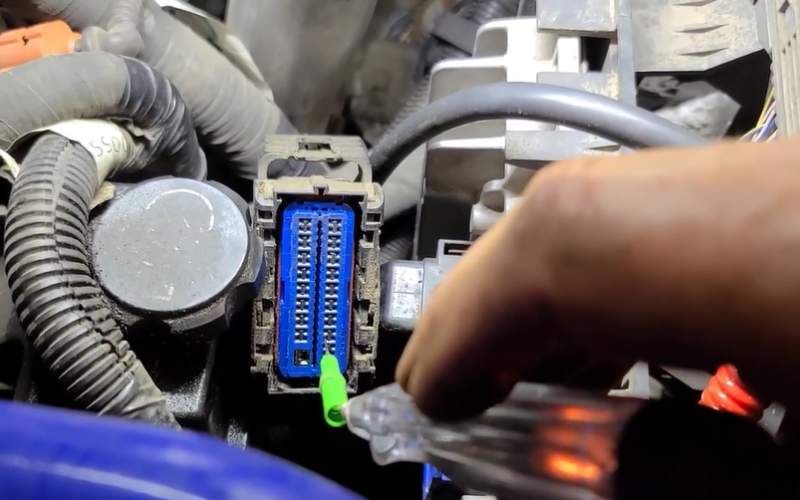How to Fix the P2033 DTC Code on Duramax (Expert Tips)
Duramax P2033 is a moderately severe DTC (diagnostic Trouble Code) that can appear on your dashboard at any time while driving. The best way to approach this code is to ask what the code means on the Duramax engine.
In technical terms, P2033 stands for “Exhaust Gas Temperature Sensor Circuit, High Bank 1 Sensor 2”, in which Sensor 2 refers to the second sensor of the engine exhaust pipe. And Bank 1 refers to the engine side with cylinder 1. However, in layman’s terms, the code P2033 denotes a high voltage in the exhaust gas temperature sensor.
In the rest of the article, I will discuss this troublesome code in more detail: why the code appears, how to fix it, and what the potential problems, causes, and effects of the code are.

What Does the Code P2033 Mean on Duramax?
To reiterate, the code P2033 denotes a high voltage in the exhaust gas temperature sensor. The sole purpose of the EGT is to check the temperature of the exhaust pipe and convert it into a voltage signal so the ECM can recognize it. If the engine control module detects voltage that is out of range, it will turn on the engine light while it stores the code.
To give you a better understanding of the code. Here is a breakdown of the code.
- P – denotes the vehicle’s powertrain.
- 2 – Stands for fuel and air metering.
- 0 – refers to Ambient Air Temperature Sensor Circuit Low
- 3 – indicates Injection Pump Fuel Metering Control ‘A’ High
- 3 – Refers to Exhaust Gas Recirculation Sensor B Circuit High
How serious is the code P2033 on the Duramax?
P2033 on Duramax, unlike other DTC codes, is a moderately severe code but has to be corrected as soon as possible. If you ask me, why? Read the answer below:
P2033 is a moderately severe code, as previously stated. The code indicates that the particulate filter in your Duramax may need to be replaced.
If you’re lucky, a simple cleaning will solve the problem. EGT adjusts the timing of the diesel particulate filter based on temperature, and faulty EGTs fail to do its job, causing further damage to the problem.
In addition, if the sensor fails to function properly, it will be unable to protect the converter from harm. For all of the reasons stated above, it is recommended that you fix the code as soon as possible to reduce the severity of the code.
What are the causes of Code P2033?
There can be many causes for this code to appear. These are the most important factors to consider when working with this code.

- PCM detects sensor temperature out of range
- Improper flow of voltage in the wiring
- Failed sensor
- There are leaks
- Loose connection
- EGT wire is shorted open or shorted
- Poor electrical connection
- ECM detects inappropriate voltage return
There could be other reasons as well. However, if you can resolve these issues, the code will most likely vanish.
What are the symptoms of code P2033 on Duramax?
Symptoms of P2033 aren’t always obvious. However, the most apparent symptoms are that the code will appear, and the check engine light will be turned on. The other symptoms can be:
- Particulate filter light will illuminate
- There might be a low power condition.
- There might be other related codes.
- The engine performed unexpectedly.
- The engine may produce less power.
How to Fix the Code P2033 on Duramax?
You can try fixing the code on your own if you have the necessary tools. Here is a step-by-step guide . However, the guide is provided for educational purposes only and is not intended as a professional recommendation.
Note:
You’ll need a vehicle-specific repair guide for the Duramax that matches the make, year, and engine size before you begin the diagnosis. You can get a step-by-step process, a wiring diagram, and other explanations from the guides.
Basic Tools Required
- The OBD Scanner to interpret the OBD code
- A digital Volt or ohmmeter to check the resistance or volt
- Heat gun
Step -1: Locate the Sensor

The sensor is usually located beneath the vehicle before the DPF (diesel particulate filter) on duramax trucks. Compared to other sensors, EGT is slightly different and easy to find.
Ensure there are no wires or tears in the connector after you’ve located the sensor. Also look for any loose terminals.
Step -2: Disconnect the Sensor and Check the Resistence

Now that you’ve found the sensor, remove the EGT. Because EGT is just a two-wire plug, it’s very easy to remove. Inspect the wire for possible damage after removing the sensor.
Now comes the most important part: determining the resistance. Check the specified range for the resistance of the particular sensor; if the actual and manufactured specified ranges differ, the sensor should be replaced.
Step -3: Check Voltage
Heat the sensor with a heat gun to determine its resistance. When the EGT is heated, the resistance increases. If this isn’t the case, the sensor must be replaced.
The voltage of the engine side cable connector should be checked. If the voltage is not within the expected range, take the necessary action.
Step -4: Recheck
After you’ve double-checked everything and taken the necessary steps, take a test drive to see if the code has returned. You may require professional assistance if the code returns.
The Cost of Fixing the Code P2033
Before you decide to fix the code, make sure how much you realistically have to spend. Several factors determine the cost of repairing the code. If you decide to do it yourself, you will need essential repair tools such as a scanner, which may cost you somewhere between $60 and $100.
If you hire a professional to complete the same task, you should expect to pay between $150 and $200. This cost depends on the hourly rate, location of your house, and experience of the professional.
You must also pay for specific replacement parts such as the EGT ( exhaust gas temperature sensor) and other components. You may also be required to pay for additional charges such as tips, travel or tax.
Can you drive the with code P0101?
The code is moderately severe, so driving the car with it should not be a major issue. There are many causes for the code, such as PCM detects sensor temperature out of range, improper flow of voltage in the wiring, failed sensor or leaks in the wiring. However, such causes may be a warning factor, but they should not stop you from driving.
Conclusion
Do not be perplexed by the code. Duramax’s code P2033 should no longer be intimidating as you have learned everything about it.
When a code appears, the first thing that should come to mind is what the code means in order to determine its severity. The next step is to figure out why the code exists. As soon as you have a reason, consult with the technician.
I believe the article was informative, and you successfully resolved the Duramax P2033 error code.
- Read Also>> How to Fix P2263 Code on Duramax? (Completely Explained)
- Read Also>> How to Fix P2149 Code On Duramax? (Completely Explained)
- Read Also>> How to Fix P2146 Code On Duramax? (Completely Explained)
- Read Also>> How to Fix P0735 Code On Duramax? (Completely Explained)
- Read Also>> How to Fix P0677 Code On Duramax? (Completely Explained)




